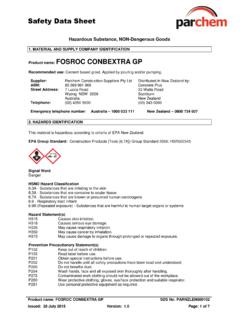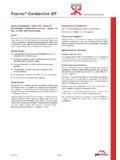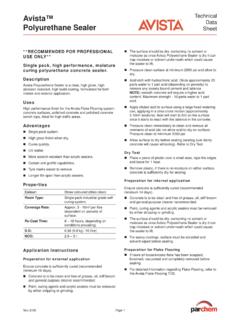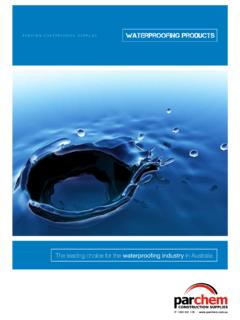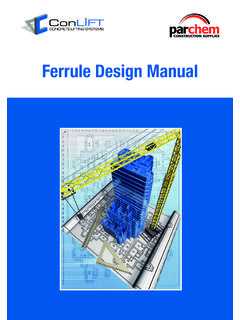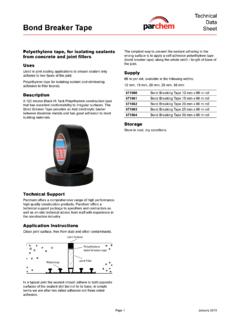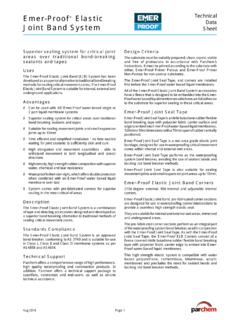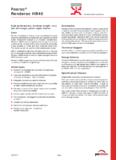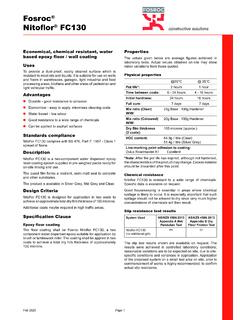Transcription of A Practical Guide to Grouting - Parchem
1 Filling the GapA Practical Guide to Groutingconstructive solutions2 Introduction 31. Selecting the correct Definition of a grout What is important when choosing a grout ? Effective Bearing Area (EBA) Shrinkage Strength Workability 12 2. Specifying Specifying the grout to be used 15 3. Installing Preparation of the foundation Machine / Baseplate installation Anchor bolts Formwork Pre-soak the substrate Mixing Placement Curing and protection 28 4. Meeting the Australian Standards 29 5. Product Reference and Information Sheets 32-44 Contents23 This Guide has been compiled by Parchem Construction Supplies on the basis of current general information. It is intended as a general Guide only and does not constitute advice in respect of any specific product or application. It is your responsibility to assess and verify the accuracy, completeness and reliability of the information in this Guide , and to seek appropriate advice where necessary.
2 Parchem makes no representations or warranties with respect to this Guide or its contents. Parchem , its related companies, directors, employees, shareholders and other representatives will not, under any circumstances, be liable for any injury, loss or damage arising out of or relating to the use of the information in this installation of machinery and securing structural steel to foundations are processes which at first may seem straight forward. Simply bolt the unit down to the foundation concrete but this is rarely the case in real life. For example, the machine base may need to raised or lowered to match up with other equipment; the foundation may be uneven meaning a baseplate will only rest on the high points creating an uneven load purpose of a grout used in commercial or civil construction is to fill gaps and voids which we deliberately leave during construction to make placement of items possible without having to be too critical with say, the foundation or plinth on which the item is to be positioned.
3 For example, the concrete foundation for a large electric motor will be cast perhaps 30mm lower than where the bottom surface of the motor base plate is going to sit; the motor is positioned and levelled using shims or levelling screws; and the nominal gap between the base plate and the foundation is subsequently grouted so that the weight of the motor is spread evenly over the whole area of the baseplate on to the foundation below. Well, that s how it should work in theory - unfortunately it is a little more complex in practice and failures sometime occur due to a variety of specification and site related document aims to address many of these issues - both at the specification stage and at the application stage. Written in simple terms it is intended as a general Guide to both specifiers and contractors and is based on general industry knowledge. It is not intended to serve as a project-specific resource as applications will necessarily vary based on a variety of factors, including site conditions and intended use.
4 Specific advice on individual project installations should always be sought from grout suppliers such as Parchem Construction is made in the document to the following Australian Standards:AS 2000 and - Definition of a groutSo we can begin with the same understanding, the following is offered as a definition of a grout :A grout is a stable material which, after having been applied in a dry-pack, plastic, flowable or fluid state, will set to fill a void. After setting, the grout provides permanent, strong and total infilling of the original void to the required performance of the terms used in this definition will be explored in detail throughout this What is important when choosing a grout ?Before we consider the technical properties and the installation of grouts we need to be mindful of the particular project we are working on. It is important to ensure we don t under specify a product but also allow for the use of lesser performing products in less critical applications to provide a more cost effective installation.
5 For example, while the grout used to install a multi-million dollar gas turbine needs to perform a similar function as a grout used under a tilt-slab wall panel - the cost difference between a high performance grout and a lesser performing grout is insignificant compared to the cost of shut-down and replacement of the grout if the grout under the turbine fails to perform. grout manufacturers like Parchem have broad ranges of Grouting products to enable specifiers to select the correct grout for their particular application. There is no one grout that is appropriate for every application - so what is important to each application? Effective Bearing Area (EBA)The aim of most Grouting applications is to evenly spread the weight and transfer the load of a machine being installed over the full area of its baseplate on to the foundation below. Achieving 100% Effective Bearing Area (EBA) is ideal but a figure which is rarely met. Although not covered in any Australian Standard, ASTM C1339-02 provides a Guide to EBA where after a polymer (resin) grout is flowed under a plate and the grout hardens, the plate is removed and the grout surface wire brushed to expose any surface air bubbles or voids.
6 A visual estimate is then made of the percentage of the grout top surface that is in contact with the plate. As part of the subsequent report the percentage bearing area is expressed as:High (greater than 85%); Medium (70 to 85%) and Low (less than 70%)Above; Visual Guide of 85% EBAB elow: Grouting of a bearing pad where only around 30% EBA was achieved with a cement based grout fortunately the issues were investigated and rectified for the subsequent pours. Selecting the correct ShrinkageIn our definition at the beginning of this document, we mentioned total infilling of the original void . If the grout we install under a base plate shrinks significantly, it is possible that the grout could shrink away from the underside of the baseplate and therefore would not be supporting the baseplate at all (in the worst case scenario). Shrinkage can also lead to cracking in the grout which can be detrimental to the installation. Looking first at cement based grouts, these materials are essentially fine concretes - cement, aggregate and admixtures in a bag - to which we add water on site.
7 Concrete shrinks - so does a cement based grout . What we need to do is minimise or compensate for this shrinkage, hence the term Shrinkage Compensation . Rather than trying to totally eliminate shrinkage, we can limit it to a point where it becomes insignificant to the final result on site. Two types of shrinkage exist in cement based grouts - shrinkage in the plastic phase and long term drying shrinkage in the hardened phase of the grout . Several processes on site as well as admixtures within the material can contribute to minimising shrinkage in cement based grouts. They include:Moisture loss during application - losing water from the mix during and after application will result in a volume change shrinkage in the plastic phase. This can be limited by restricting unrestrained (open) surfaces to stop evaporation and by pre-soaking the concrete foundation to stop water in the grout being absorbed into dry concrete. Subsequent moisture loss during the curing of cement based grouts is also a problem and should be minimised with the use of curing compounds or wet hessian/burlap onto exposed surfaces once the grout has achieved initial set, then onto other surfaces once forms are generating admixtures - chemicals are formulated into the grout which react when the grout is mixed to produce small bubbles of gas (hydrogen or nitrogen) which essentially make the grout expand around 2% while it is still unset (plastic).
8 This again is shrinkage compensation in the plastic phase. The gas does not affect the strength of the grout and generally occurs during the first 30 minutes after mixing/placing. These types of grout were previously known as Class A grouts (SAA Misc Pub MP20,Part3-1977). Some markets (underground mining in particular) are sensitive about hydrogen production in grouts due to the aluminium powder used in the grout to generate the gas. There is also a belief that hydrogen embrittlement may occur when a hydrogen producing grout is used near high tensile steel using a nitrogen producing grout negates this. Expansive cements - grouts in the higher performance spectrum will generally contain some amount of expansive cements which help compensate for shrinkage after the grout has set and initially hardened. This technology is normally aligned with gas producing expansion technology to produce what is known as Dual Shrinkage Compensated grouts. These grouts were previously known as Class A/C grouts (Class C if they only expanded in the set/hardened phase).
9 Shrinkage in resin based grouts depending on the type of resin being used, shrinkage can be significant in resin based grouts. Polyester based formulations are quick to set but can exhibit up to 8% shrinkage which makes the technology unsuitable for most Grouting applications. Well-formulated epoxy resin based grouts will only exhibit minimal shrinkage (around 1%), - but this could still be enough to create potential problems when used in large volumes and deep sections. Epoxy resin based grouts are generally formulated to be used within a range of gap sizes to ensure shrinkage is controlled. One of the features of epoxy based grouts is their ability to bond to the concrete foundation and the base plate. During the initial cure time of the grout when shrinkage is likely, the grout is likely to be bonded to the base plate and this will reduce the possibility of the grout shrinking away or even cracking under the base plate. Any tension built up at the time should relax out over time due to the plastic nature of epoxies.
10 Experience has shown that even when shrinkage cracks occur in the unrestrained grout around the perimeter of a base plate grout , the cracks rarely continue for more than 20mm or 30mm under the StrengthGrout strength is tested according to the Australian Standard AS1478-2005 and the figures quoted by manufacturers are established under controlled conditions which may differ from the results often reported for site prepared samples. There are several types of strength which relate to Grouting which are described below in simple terms; Compressive strength - the ability of the grout to resist the weight of the machine or item being placed on it; typically a static downward force. Most grouts these days will exceed 50 MPa at 28 days, some reaching over 100 MPa. A grout should achieve well above the compressive strength of the concrete is it placed on but there seems little advantage in placing 100 MPa grout on 40 MPa concrete foundations other than possibly the associated increase in tensile strength of the grout (discussed below).
